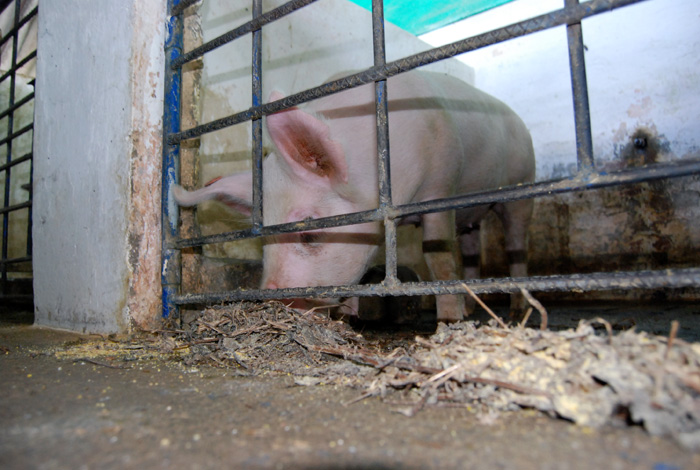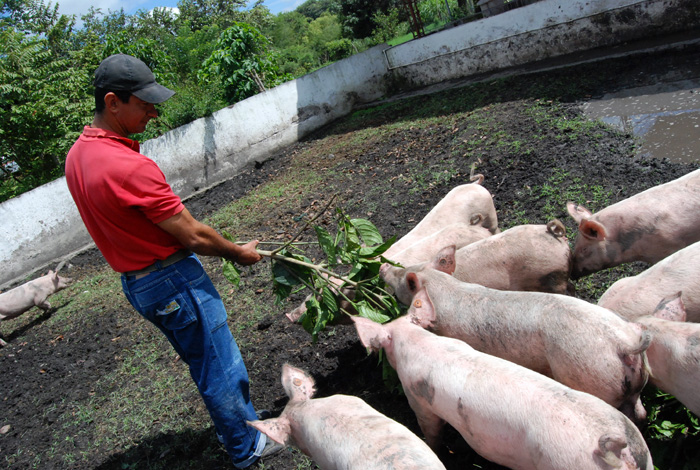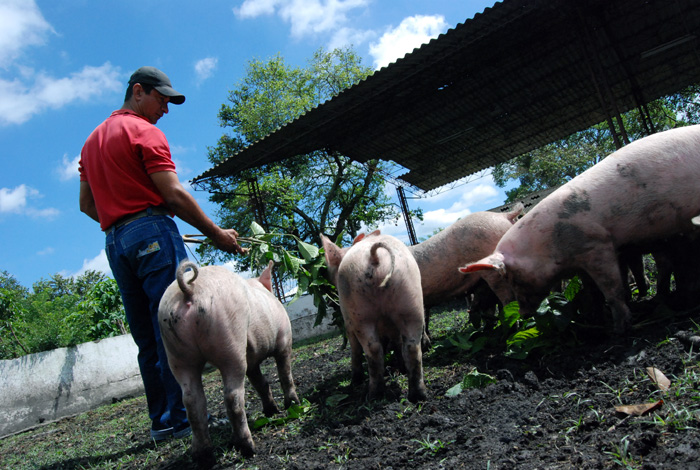According to the Business Opinion survey made by the Colombian Association of Pigfarmers (Porcicol, for its acronym in English), during the first semester of this year, the pork price fell dramatically, but the production costs increased. This situation is the result of an increase in the international prices of the main raw materials for the production of food for these animals, such as corn and soy cake.
The total amount of importation of raw materials for the production of balanced food for pigs increased 2.1% in the first five months of the year, in comparison to the same period of 2010.
For this reason Patricia Isabel Sarria, a Magister zootechnician, studies new food alternatives that can substitute soy cake for the nutrition of pigs. This doctorate candidate in Agricultural Sciences and professor of Universidad Nacional de Colombia in Palmira works together with the International Center for Tropical Agriculture (ICTA).
During this study, the researchers found caupi and canavalia (species of fodder legumes), two efficient food options that pigs adopted in their diet and that represent almost a 50% saving for pigfarmers in the country.
High levels of protein
Caupi is an herbaceous legume originated in the south west of Africa and highly cultivated in Latin America. It is also known as "cowpeas". It is a forage of hot weather that tolerate dry seasons.
Incredibly, according to experts, this plant has produced a ton of dry grain per hectare in Sahara environments with just 181 millimeters of rain per crop. This is little water distributed in several square meters of land.
Professor Patricia Sarria asserts that "caupi seeds are rich in proteins and have a high content of amino acids, lysine and tryptophan, that if compared to the nutritional value of cereals, could be similar to beans. Besides, its leaves have an important content of protein and an acceptable digestibility, for this reason, they are a perfect complement for the pigs" diet."
Likewise, Canavalia brasiliensis is also an herbaceous legume with an eight month cultivation cycle with leaves of 12 cm long and 10mm wide, it also tolerate dry seasons and adapts to both low fertility clay soils and sandy soils. Both plants, according to the study, can replace close to 50% of soy cake.
The plants are tested with pigs
The evaluation of new food alternatives for pigs is made by CIAT in countries such as Honduras, Nicaragua, Republic of Congo and Colombia. In our country, Mario Gonzales Aranda Lab from Universidad Nacional de Colombia in Palmira was chosen to perform the acceptance, digestion and grow test on the pigs. Profesor Sarria was in charge of the process.
Caupi and canavalia crops, cultivated by CIAT in Santander de Quilichao (Cauca), are sent to the laboratory for reserchers to evaluate its acceptance among pigs, and evaluate the animal"s degree of tolerance and digestive behavior.
"During 14 days, we give them 600 grams of caupi or canavalia every day. On the first stage of acceptance, we replace almost 40% of the food to monitor the amount consumed by the animals and the amount rejected," asserted the zootechnician.
During this stage, the researcher identified that pigs consume this food without any problems and a significant acceptance.
On the second and third evaluation stages, digestibility test were performed to identify the amount of nutrients assimilated by the animals" organism and the behavior regarding growth and meat quality.
Results show that caupi grain can be digested like soy grain and its nutrients contain high amounts of proteins that could replace almost 50% of soy. Meanwhile, the caupi foliage can replace up to 30% and canavalia 20% of it," asserted the scientist.
It was proved that pigs feed with the new forage grew in a similar way that those feed with traditional soy cake, with the same 600 grams daily.
This represents a 50% saving for pigfarmers when buying raw materials for the production of food for the animals. Normally, they spend COP 32.400 to buy 18 kilograms of soy per month; with caupi and canavalia, they would need to invest only COP16.200 in each pig per month.
For professor Sarria, "this would strengthen the sector of pigfarmers in Colombia that now conts with a rustical, reliable and cheap vegetable that can be cultivated in any terrain."
 Correo Electrónico
Correo Electrónico
 DNINFOA - SIA
DNINFOA - SIA
 Bibliotecas
Bibliotecas
 Convocatorias
Convocatorias
 Identidad UNAL
Identidad UNAL





